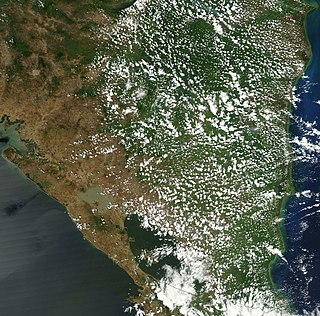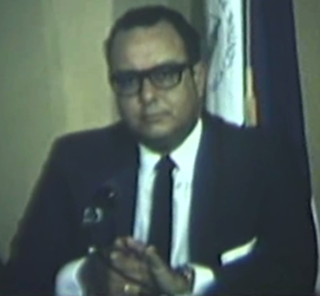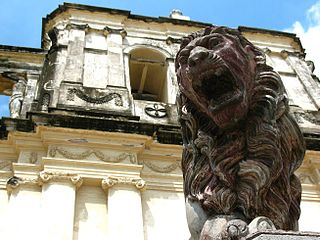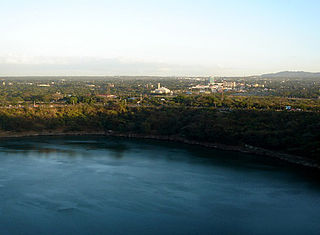Related Research Articles

Central America is a subregion of the Americas. Its boundaries are defined as bordering Mexico to the north, Colombia to the south, the Caribbean Sea to the east, and the Pacific Ocean to the west. Central America consists of seven countries: Belize, Costa Rica, El Salvador, Guatemala, Honduras, Nicaragua, and Panama. Within Central America is the Mesoamerican biodiversity hotspot, which extends from northern Guatemala to central Panama. Due to the presence of several active geologic faults and the Central America Volcanic Arc, there is a high amount of seismic activity in the region, such as volcanic eruptions and earthquakes which has resulted in death, injury, and property damage.

Nicaragua, officially the Republic of Nicaragua, is the largest country in Central America, bordered by Honduras to the north, the Caribbean to the east, Costa Rica to the south, and the Pacific Ocean to the west. Managua is the country's capital and largest city. As of 2015, it was estimated to be the second largest city in Central America. Nicaragua's multiethnic population of six million includes people of mestizo, Indigenous, European and African heritage. The main language is Spanish. Indigenous tribes on the Mosquito Coast speak their own languages and English.

Nicaragua is a country in Central America, bordering both the Caribbean Sea and the North Pacific Ocean, between Costa Rica and Honduras. Nicaragua is the largest country in Central America in square kilometers.

Managua is the capital and largest city of Nicaragua, and one of the largest cities in Central America. Located on the shores of Lake Managua, the city had an estimated population of 1,055,247 as of 2020, and a population of 1,401,687 in its metropolitan area. The city also serves as the seat of Managua Department.

Anastasio "Tachito" Somoza Debayle was the President of Nicaragua from 1 May 1967 to 1 May 1972 and from 1 December 1974 to 17 July 1979. As head of the National Guard, he was de facto ruler of the country between 1972 and 1974, even during the period when he was not the de jure ruler.

León is the second largest city in Nicaragua, after Managua. Founded by the Spanish as Santiago de los Caballeros de León, it is the capital and largest city of León Department. As of 2021, the municipality of León has an estimated population of 212,504.

Chinandega is a city and the departmental seat of Chinandega department in Nicaragua. It is also the administrative centre of the surrounding municipality of the same name. It is Nicaragua's 2nd most important city (economy) and 6th largest city, with a population of 114,417, and a total of 137,170 in the municipality. It is located about 134 kilometres (83 mi) northwest of Managua and about 72 kilometres (45 mi) southwest of El Guasaule, on the border with Honduras. Chinandega is situated about 20 kilometres (12 mi) from the Pacific Ocean.
Mateare is a town and a municipality in the Managua department of Nicaragua. The municipality covers an area of 297 km2 and has an estimated population of 62,027.

San Juan del Sur is a municipality and coastal town on the Pacific Ocean, in the Rivas department in southwest Nicaragua. It is located 140 kilometres (87 mi) south of Managua. San Juan del Sur is popular among surfers and is a vacation spot for many Nicaraguan families and foreign tourists.

Nicaragua's economic history has shifted from concentration in gold, beef, and coffee to a mixed economy under the Sandinista government to an International Monetary Fund policy attempt in 1990.

Tip-Top(often referred to as 'Pollo Tip-Top') is a national chain of restaurants in Nicaragua, predominantly selling chicken. It is headquartered in the country's capital city of Managua and is a franchise of Tip Top Industry.

Tiscapa Lagoon is a lagoon of volcanic origin that formed over 10,000 years ago. It is located in the capital city of Managua in Nicaragua, and covers an area of 0.13 km2. Tiscapa Lagoon was protected as a natural reserve on October 31, 1991. The reserve is managed by the Ministry of the Environment and Natural Resources (MARENA) and comprises one of the 78 protected areas of Nicaragua.
The 1931 Nicaragua earthquake devastated Nicaragua's capital city Managua on 31 March. It had a moment magnitude of 6.1 and a maximum MSK intensity of VI (Strong). Between 1,000 and 2,450 people were killed. A major fire started and destroyed thousands of structures, burning into the next day. At least 45,000 were left homeless and losses of $35 million were recorded.
The 1972 Nicaragua earthquake occurred at 12:29:44 a.m. local time on December 23 near Managua, the capital of Nicaragua. It had a moment magnitude of 6.3 and a maximum MSK intensity of IX (Destructive). The epicenter was 28 km (17 mi) northeast of the city centre and a depth of about 10 km (6.2 mi). The earthquake caused widespread casualties among Managua's residents: 4,000–11,000 were killed, 20,000 were injured and over 300,000 were left homeless.
The 1992 Nicaragua earthquake occurred off the coast of Nicaragua at 6:16 p.m. on 1 September. Some damage was also reported in Costa Rica. At least 116 people were killed and several more were injured. The earthquake was caused by movement on a convergent plate boundary. It created a tsunami disproportionately large for its surface wave magnitude.
The 1956 Nicaragua earthquake occurred on October 24 at 14:42 UTC. The epicenter was located west of Masachapa, Managua Department, Nicaragua. It was an earthquake of magnitude Ms 7.3, or Mw 7.2. Building damage was reported in Managua. A study of W. Montero P. shows that this earthquake might be related to the earthquake of Nicoya Peninsula on October 5, 1950. A tsunami was triggered by the earthquake.
León Airport is an airport serving León, the capital of the León Department of Nicaragua. The airport is on the southwest side of the city.
The October 2014 Nicaragua earthquake occurred at 21:51 local time with a moment magnitude of 7.3 off the coast of Nicaragua, Honduras and El Salvador. The shock resulted in four deaths and several injuries.
The 2000 Nicaragua earthquake occurred at 19:30 UTC on July 6. It had a magnitude of 5.4 on the moment magnitude scale and caused 7 deaths and 42 injuries. 357 houses were destroyed and 1,130 others were damaged in the earthquake.
The following lists events in the year 2022 in Nicaragua.
References
- ↑ "M 5.9 - 6 km E of La Conquista, Nicaragua". earthquake.usgs.gov.
